
IMMERSE YOURSELF
IN THE PUBLIC ART AT MQ
Explore a range of curated art and culture at Melbourne Quarter.
Positioned throughout the precinct, you can browse the collection of artworks ranging from sculptures and installations, to light projections by world-renowned artists.
Find out more about the collection below.
Find your side to Melbourne Quarter. It’s yours to explore.
- Close all
-
Your Lordship has been Forturnate, by John Warwicker
Location: One Melbourne Quarter lobby
Typographical artwork: John Warwicker | Accompanying text: Bruce Pascoe
Creative Direction: Lou Weis, Broached Commissions | Architectural design: Denton Corker Marshall
Photographer: Peter Bennetts
The artwork on the upper walls of the foyer features a typographical interpretation of a letter from Captain John Lancey to his employer, the co-founder of Melbourne, John Fawkner in 1835, the year Melbourne was founded.
Lancey’s observations were made where this building stands today. John Batman ended up buying the lot and it became known as Batman’s Hill.
Bruce Pascoe (a renowned author and scholar of Indigenous agriculture and language) of Bunurong, Yuin and Tasmanian heritage has provided a contemporary interpretation of the letter, highlighting the hill as an Indigenous garden maintained by the Kulin Nation for generations.
Artist John Warwicker selected fonts like the Caslon typeface, which date back to Melbourne’s founding era and were used in official British Government documents, thereby paying homage to the formal aesthetics of the British Empire.
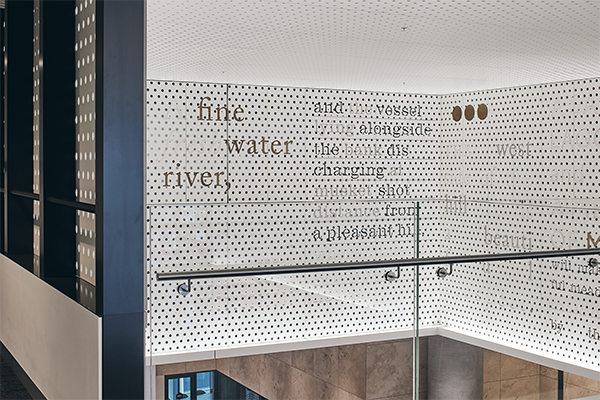
-
Grass Parrot Family, by Emily Floyd
Location: TiTree Park, East Tower Residential Apartments
Curator: Broached Commissions
Photographer: Peter Bennetts
Emily Floyd’s artwork was designed to specifically engage Melbourne Quarter’s younger residents by reimagining the city from a child’s perspective. “Grass Parrot Family,” transforms the urban park into an outdoor classroom, blending childhood learning with local fauna.
The sculptural birds are modeled on the Red Rumped Parrot (Psephotus haematonotus), also known as the red-backed parrot or grass parrot, a common bird of south-eastern Australia.
Floyd also acknowledges and pays respect to the Traditional Owners and Elders, past present and emerging, of the lands and waters on which Ti-Tree Garden stands; acknowledging Aboriginal connection to material and creative practice on these lands for more than 60,000 years, and their enduring presence and knowledge.
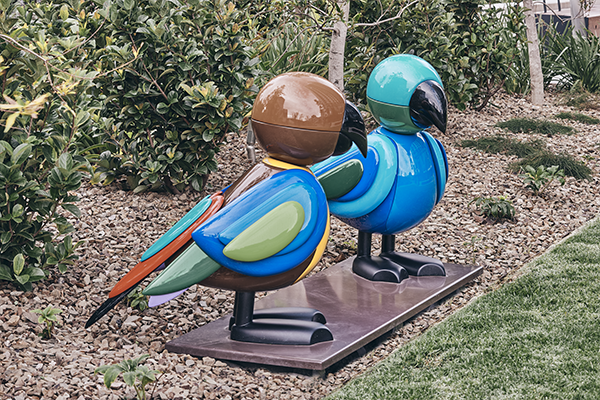
-
Colourama, by Aspect | Oculus & Broached Commissions
Location: TiTree Park, East Tower Residential Apartments
Curator: Broached Commissions
Photographer: Peter Bennetts
The Colourama pavilion blends high modernist lines with playful elements. It features overhanging eaves and a square core inspired by traditional Japanese tea houses, but with a rectilinear, Western modernist twist.
The sliding dichroic glass screens merge traditional Japanese shoji screens with Bauhaus-inspired color play. Visitors can interact with the sliding panels to create various contrasts of color, shadow, and pattern, experiencing the pavilion as a playground, maze, or sanctuary.
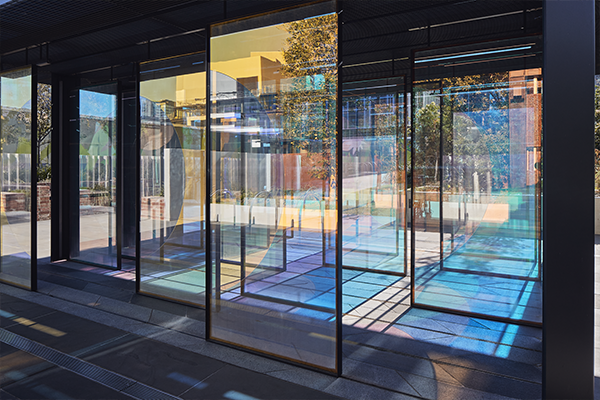
-
Stumped by Trent Jansen
Location: TiTree Park, East Tower Residential Apartments
Curator: Broached Commissions
Photographer: Peter Bennetts
The Melbourne Cricket Club played some of its first games at the foot of Batman’s Hill, now Melbourne Place. To honor this significant moment in Melbourne and Australia’s sporting history, Lendlease commissioned a commemorative set of cricket stumps. Designed by Trent Jansen, the stumps are imagined as being crafted in a makeshift mold using local timber.
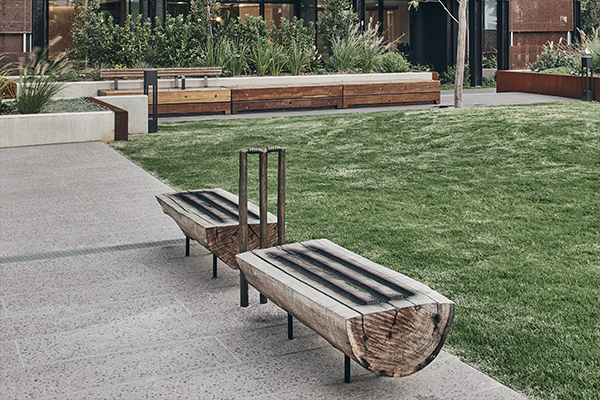
-
Gunpowder Empires, by U-P
Location: Gunpowder Walk, near Two Melbourne Quarter. Viewable after sunset.
Curator: Broached Commissions
Photographer: Peter Bennetts
Batman’s Hill, a founding site of colonial Melbourne, once housed a gunpowder storage facility crucial for the colony’s expansion.
Five circular Gobo light projections on Gunpowder Walk trace the deadly history and evolution of gunpowder from its origins in China during the Song Dynasty, to its use in the Ottoman Empire and across Europe. From gunpowder use during the Song Dynasty, China (960-1279) culminating in American Civil War-era patent drawings for pistols and rifles (1861 – 1865). These projections highlight the transformative impact of gunpowder from the glory of the feudal Empire through to the rise of the American empire, which coincides with industrial scale munition manufacture.

-
Landscape Amnesia by Stanislava Pinchuk; Kharkov; Ukraine; Reko Rennie (Kamilaroi)
Location: Viewable from Gunpowder Walk, near Two Melbourne Quarter
Curator: Broached Commissions
Photographer: Peter Bennetts
Reko Rennie and Stanislava Pinchuk began their artistic journeys in street art. “Landscape Amnesia” reflects their ongoing commitment to using simple symbols to make bold political statements. In this piece, Pinchuk and Rennie employ net-like lines and Reko’s vivid shield patterns to create a distorted landscape over the rectilinear grid of commercial office windows.

-
Fire by Yhonnie Scarce
Location: Melbourne Square, outside Two Melbourne Quarter
Curator: Broached Commissions
Photographer: Peter Bennetts
Yhonnie Scarce’s memorial to the murnong plant, a root vegetable once harvested by the Kulin Nation, features hand-blown glass objects representing the plant in various states; buried, as if in a firepit, in their natural subterranean state, and also laid out as if ready to eat.
This artwork, located on what was once an Indigenous garden, serves as a tribute to sustainable Indigenous agriculture. According to Bruce Pascoe, early colonial records noted the site’s rich array of edible herbs and plants. Scarce’s work is both archaeological and ceremonial, encouraging a return to traditional practices.
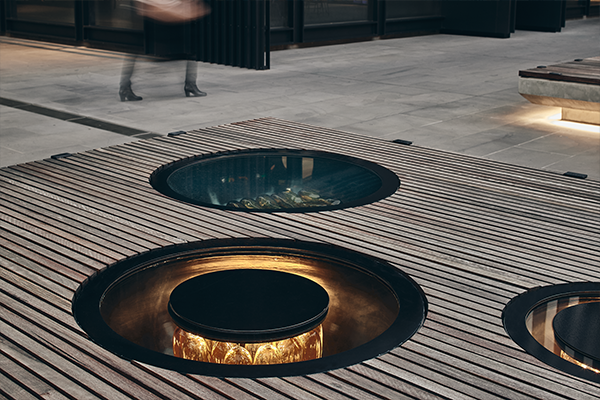
-
Embodied by Grace Lillian Lee
Location: Melbourne Quarter East elevation, best viewed from the corner of Flinders Street and Wurundjeri Way.
Curator: Broached Commissions
Photographer: Peter Bennetts
Grace Lillian Lee’s sculpture, “Embodied,” is a tribute to Binbeal, the Kulin Nation god of the rainbow, son of Bunjil. “Embodied” is Lee’s first public art commission and expands on her fashion practice of body-armour and cloth weaving.
The screen sculpture resides on the back wall of the Oculus-designed pavilion situated at the East end of Melbourne Square. It symbolizes the rain collected by Binbeal which is woven into a rainbow and body armour. The folded, laser-cut, metal weave pattern is inspired by Torres Strait Island weaving techniques.
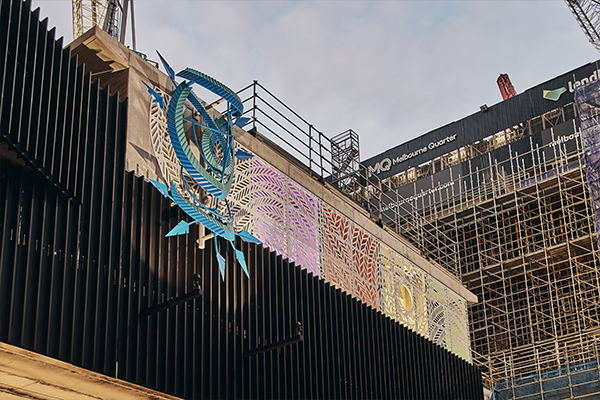
-
Batman’s Hill Marker by Broached Commissions and Maree Clarke
Location: Melbourne Quarter Square
Artists: Broached Commissions (founded 2011), Maree Clarke (B. 1961, Melbourne. Mutti Mutti, Yorta, BoonWurrung Wemba woman)
This installation marks the key historical site of Batman’s Hill. Surveyor Robert Hoddle stood atop the hill, using it as a vantage point to chart the city’s now-iconic central grid - a moment that helped shape the city.
In response to this rich historical context, Broached Commissions reimagined the surveyor’s tool, the theodolite, as the main sculptural object and inviting artist Maree Clarke to place a kaleidoscopic artwork as the lens through which to view the land.
Located in Melbourne Quarter Square, the precinct and beyond are abstracted by the glass artwork that references the cellular structure of river reeds. The reeds are a central part of Maree’s practice, and continue the historical practice of Louisa Briggs, who used the reeds to create Welcome to Country necklaces.
The theodolite’s design draws from a 19th-century antique, while its plinth speaks to the vertical rise of architecture within Hoddle’s grid, a nod to the city’s evolution from mapped lines to towering forms.
